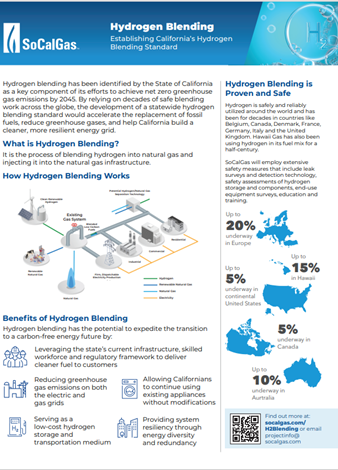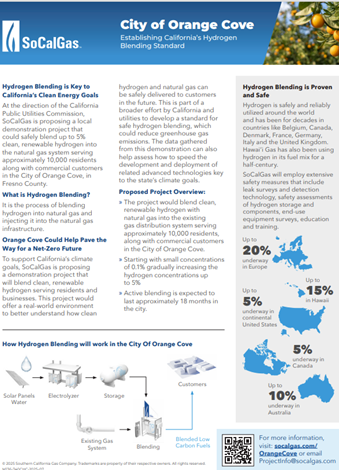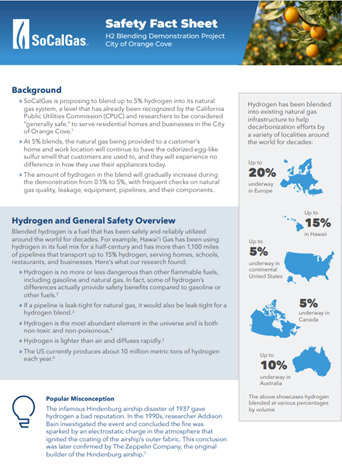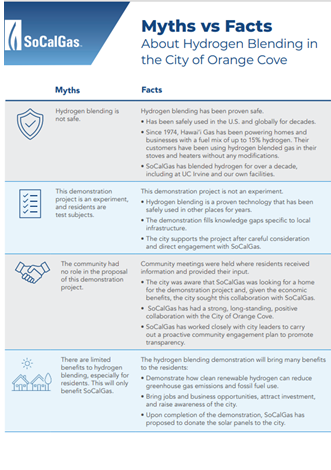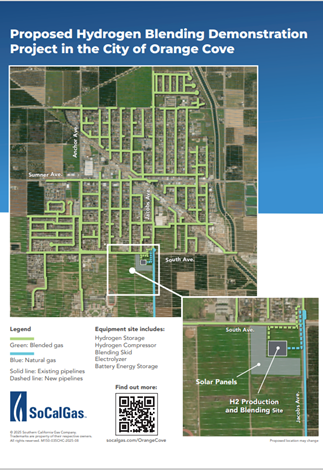
Project Update
SoCalGas values its role in the Orange Cove community and is committed to being a good neighbor. As we continue striving to deliver natural gas in a safe, reliable, and affordable manner, we remain committed to transparency with the community regarding our proposed hydrogen blending demonstration project.
On August 25, 2025, the California Public Utilities Commission (CPUC) held two public participation hearings (PPHs) at 2:00 pm and 6:00 pm at the Orange Cove Community Center. The PPHs were scheduled by the CPUC in May 2025 in connection with the Joint Amended Application filed by SoCalGas, SDG&E, PG&E, and Southwest Gas proposing hydrogen blending demonstration projects, as directed by the CPUC. These hearings allow the public to learn about the projects, share opinions, and communicate directly with the CPUC.
We want to extend our sincere thanks to everyone who attended the August 25th PPHs and shared their valuable feedback. We know some of you still have questions and want more information. We're committed to keeping the conversation going. Soon, we'll be announcing more opportunities for the community to learn about the proposed project and share feedback. We continue to encourage the community to remain engaged and informed about the proposed demonstration project. For more information, please visit the CPUC’s website.
Project Overview
At the direction of the California Public Utilities Commission, SoCalGas is proposing a local demonstration project that could safely blend up to 5% clean renewable hydrogen into the natural gas system serving approximately 10,000 residents, along with commercial customers in the City of Orange Cove, in Fresno County. Active blending is expected to last approximately 18 months in the city.
This project would also help to support California's climate and clean air goals. This project would offer a real-world environment to better understand how clean renewable hydrogen and natural gas can be safely delivered to customers in the future. This is part of a broader effort by California and utilities to develop a standard for safe hydrogen blending, which could reduce greenhouse gas emissions and improve air quality. The data gathered from this demonstration can also help assess how to speed the development and deployment of related advanced technologies key to the state's climate and clean air goals.
How Hydrogen Blending Would Work in Orange Cove
Hydrogen Blending is the process of blending hydrogen into natural gas and injecting it into the natural gas infrastructure.
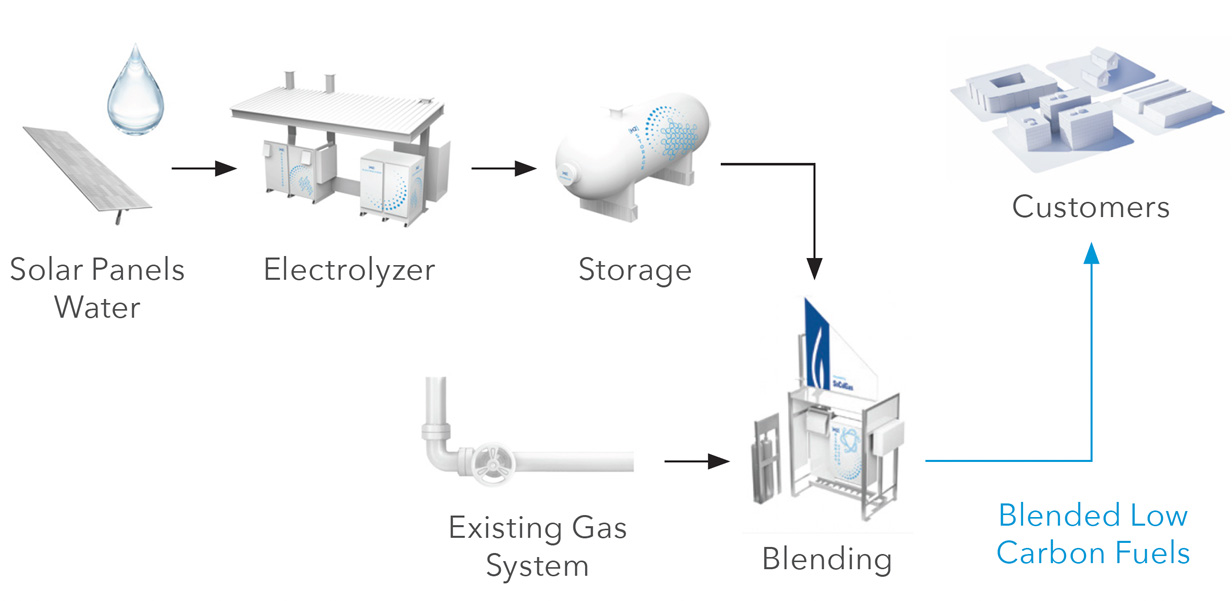
Hydrogen and General Safety Overview
Blended hydrogen is a fuel that has been safely and reliably utilized around the world for decades. For example, Hawaiʻi Gas has been using hydrogen in its fuel mix for a half-century and has more than 1,100 miles of pipelines that transport up to 15% hydrogen, serving homes, schools, restaurants, and businesses. Here’s what our research found:
• Hydrogen is no more or less dangerous than other flammable fuels, including gasoline and natural gas. In fact, some of hydrogen’s differences actually provide safety benefits compared to gasoline or other fuels.1
• If a pipeline is leak-tight for natural gas, it would also be leak-tight for a hydrogen blend.2
• Hydrogen is the most abundant element in the universe and is both non-toxic and non-poisonous.3
• Hydrogen is lighter than air and diffuses rapidly.4
• The US currently produces about 10 million metric tons of hydrogen each year.5
• For decades, hydrogen has been safely used in the chemical and refining industries.6
• Hydrogen has been blended into existing gas infrastructure to help decarbonization efforts by a variety of localities around the world for decades:

The above showcases hydrogen blended at various percentages by volume
SoCalGas Has a Robust Safety Plan for Orange Cove
We understand that those working and residing near the demonstration project locations may have concerns. Here’s how we plan to help address them:
- Install remote methane/hydrogen monitoring systems within the production facility that are active 24/7 and monitored in real-time
- Perform leak surveys before, after, and on a quarterly basis during implementation
- Survey customer equipment to confirm it is operating safely
- Conduct safety and operational tests on a monthly, quarterly, and yearly frequency based on manufacturer recommendations
- Provide hydrogen safety education for emergency personnel
- Create specific hydrogen blending customer protocols and emergency response plans
SoCalGas is Experienced with Hydrogen Blending
Blending is safe and proven and SoCalGas has been blending hydrogen with natural gas for a decade. We blended hydrogen on the University of California, Irvine campus in 2016. And today, we're blending hydrogen on our own properties, including at our [H2] Innovation Experience hydrogen home in Downey.
Come Visit the SoCalGas [H2] Innovation Experience Hydrogen Home
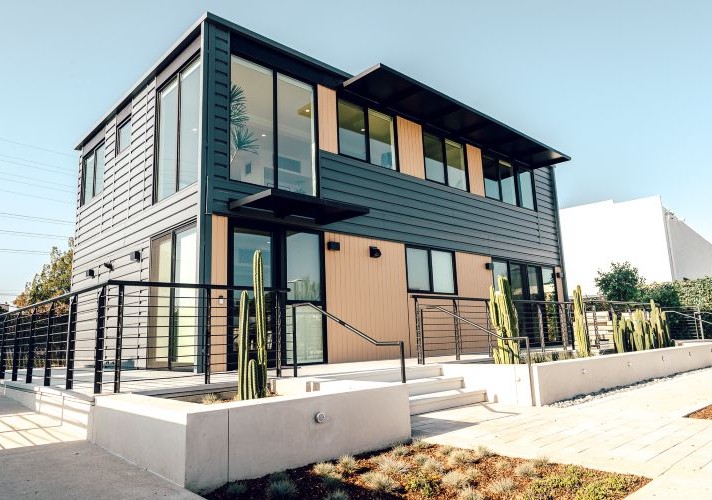
Resources
For more information, contact us at ProjectInfo@socalgas.com or 844-765-9385
1. Source: U.S. Department of Energy (DOE). Hydrogen Safety Fact Sheet [Fact Sheet]. https://www1.eere.energy.gov/hydrogenandfuelcells/pdfs/h2_safety_fsheet.pdf
2. Source: GTI Energy. Climate Impacts of Fugitive Hydrogen Emissions. Center for Methane Research. https://www.gti.energy/wp-content/uploads/2025/01/CMR-Climate-Impacts-of-H2-Emissions.pdf
3. Source: U.S. DOE. Safety, Codes and Standards [Fact Sheet]. Fuel Cell Technologies Office. https://www.energy.gov/eere/fuelcells/articles/safety-codes-and-standards-fact-sheet
4. Source: U.S. DOE. Hydrogen Safety Fact Sheet [Fact Sheet]. https://www1.eere.energy.gov/hydrogenandfuelcells/pdfs/h2_safety_fsheet.pdf
5. Source: U.S. DOE Hydrogen Production Website. https://www.energy.gov/eere/fuelcells/hydrogen-production
6. Source: WHA International, Inc Website. Top Industrial Uses of Hydrogen, and the Need for Industrial Hydrogen Safety. https://wha-international.com/hydrogen-in-industry/
